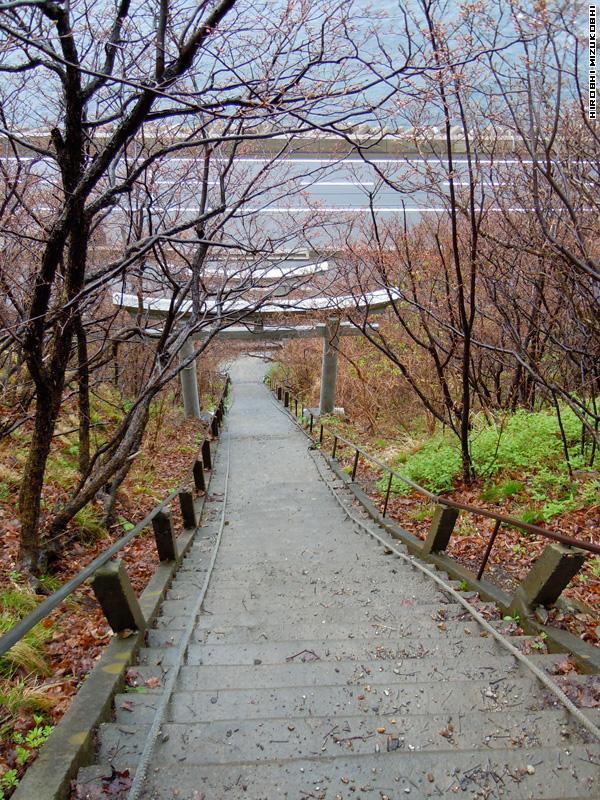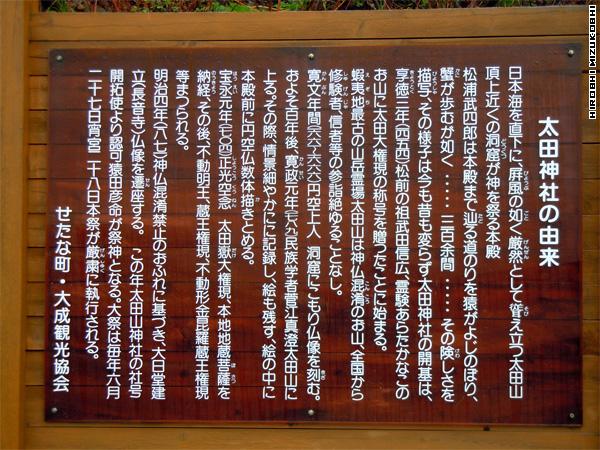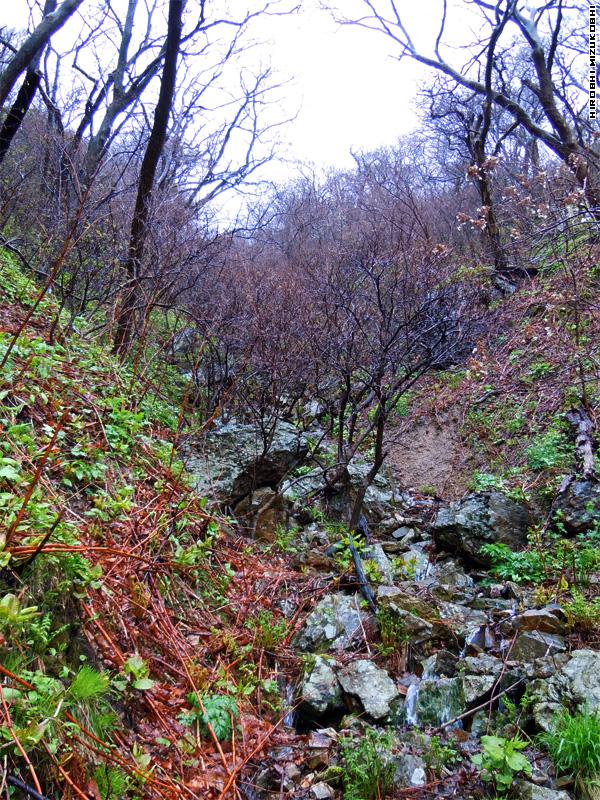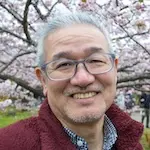Ohta Jinjya Shrine is located in Setana, southwest Hokkaido and is believed to have been constructed between 1441 and 1443, making it the oldest shrine in Hokkaido. Within the shrine precincts, there are two distinct buildings. One is the ‘Haiden,’ or front shrine, situated on a small rocky hill along the seaside, where worshipers usually pay their respects. The other building, the main shrine, is located within a cave atop Mt. Ohtasan, requiring a climb to reach for worship. It’s often said that visiting here is less like mountain climbing and more akin to an ascetic practice.
Upon approaching the shrine entrance, visitors immediately sense the solemnity of the place. The path to the shrine, known as ‘Sando’ (参道), leads straight uphill towards Mt. Ohtasan. The slope is steep, exceeding 40 degrees over a span of less than 50 meters, marking just the beginning of the ascent. Along this path, there are three ‘Torii’ gates, traditional Shinto gates believed to ward off evil spirits and purify those who pass through. Looking back from the upward climb, one might feel a sense of awe and challenge.
Towards the left side at the final steps, there is a ‘Jizo’ statue, a bodhisattva revered in Japanese culture for its protective and guiding role. Although Jizo originates from Buddhism, it is often integrated with Shinto practices in Japan, especially during the Meiji era when anti-Buddhist sentiments prevailed. This amalgamation reflects a unique cultural blend where both Shinto deities and Buddhist figures are respected.
Descending from the shrine entrance, visitors truly understand that this journey is more than a mere hike or worship—it is an ascetic practice, demanding reverence and determination.

Standing at this point, you face a pivotal decision: “To go or not to go.” This marks the beginning of the shrine entrance. If you lack essential equipment such as sturdy shoes, appropriate clothing, and water, it would be wise to reconsider your ascent. The mountain terrain harbors bears, the Hokkaido adder (the region’s only venomous snake), blackflies, and mosquitoes, making the climb challenging. From this juncture, the path narrows and becomes unstable, resembling an animal trail. However, a guiding rope along the way ensures you stay on course.
After walking another 50 meters, you’ll encounter a small stream and an iron bridge ahead, approximately 103 meters from the entrance. Yet, the journey ahead continues. Another 100 meters leads to a second small Jizo statue nestled under rocks. Further along, about 358 meters from the entrance, the path eases, surrounded by towering trees, where you’ll find ‘Nyonin-do’ (女人堂), a shelter for women, offering a place to rest.
As you ascend, the slope becomes steeper. To navigate safely, maintain your stability and grip the ropes provided along the route. While Setana Town’s website suggests a 30-40 minute climb to the shrine, this estimate may not hold for novice climbers. Takeshiro Matsuura, a renowned explorer from the late Edo period, likened the climb of Mt. Ohtasan to a feat only a demon or god could achieve in his 1856 writings, “Oni Kami Nobori,” where ‘Oni’ refers to an ogre or demon, and ‘Kami’ to a deity.
After ascending over 300 meters, the shrine finally comes into view. Perched atop a cliff-shaped mountain peak, the shrine resides within a small cave. Stepping closer, you’ll encounter a 1-meter-wide, 16-meter-long bridge. On the right, a steep valley drops away, while the left features a precipice with a 7-meter iron chain to aid your approach. Inside the cave, the shrine occupies a space 4 meters wide and 3.5 meters deep. From Ohta Jinjya Shrine, you can behold the blue expanse of the Japan Sea and gaze downward upon the Haiden shrine below. Here, amidst this awe-inspiring scenery, you’ll feel the undeniable presence of the divine.

Access
- Take a Hakodate bus to Ohta and walk 15 min.
Related Articles
Beautiful Town Esashi: Preserving the Charm of the Good Old Days
How to Experience Minshuku: Authentic Local Seafood in Shiriuchi Town
How to enjoy Matsumae-jo seeing Sakura festival in April, The Most Northern Castle in Japan


